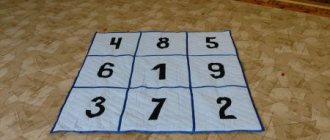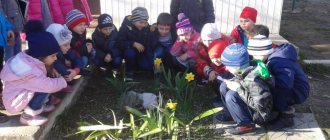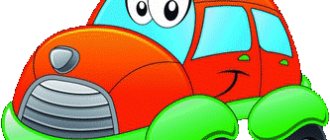Card index of security games
| №1Topic: “Child and health” Who needs what? Target: consolidate children's knowledge about the items necessary for work as a doctor, cook, or salesperson. Material: a circle divided into sectors, in each of them there are pictures depicting objects necessary for the work of a doctor, cook, seller, in the middle of the circle there are arrows, they depict a doctor, cook, seller. Progress of the game: The teacher invites the child to find an item necessary for the doctor (cook, salesperson) to work. | №2 Topic: “Child and health” Put the pictures in order Target: systematize children’s ideas about health and a healthy lifestyle, develop speech, attention, and memory. Material: pictures depicting moments of the daily routine Progress of the game: The teacher says that the wizard Confusion has mixed up the pictures of the daily routine, and suggests putting the pictures in order. The teacher summarizes the children's statements. Every morning, to be healthy, we start with exercise. In order to grow strong, dexterous and brave, we do exercises every morning. The teacher invites everyone to remember their favorite exercise, show it to everyone and do it together. |
| №3 Topic: “Child and health” Let's dress the doll for a walk Target: consolidate children's knowledge about clothing, develop children's ability to dress a doll according to the season of the year, the weather, systematize children's ideas about health, develop children's attention, memory, and logical thinking. Material: paper doll with different clothes Progress of the game: the teacher says that the doll is going for a walk, but doesn’t know what to wear, it’s winter and it’s very cold outside (various situations). Children “dress” the doll and explain their choice. | №4 Topic: “Child and health” What is good, what is bad Target: introduce children to the rules of personal hygiene and proper, careful attitude towards their health; develop children's speech, attention, and memory. Material: fields divided into squares, in the center of the field there is a negative and positive picture, pictures with different situations. Progress of the game: 2nd option. Showing pictures can be accompanied by children's motor activity. For example, children react to positive pictures by jumping, and when shown a negative picture they sit on the floor. |
| №5 Topic: “Child and health” ABC of health Target: systematize children’s ideas about health and a healthy lifestyle, develop speech, attention, and memory. Material: illustrations Progress of the game: play from 1 to... people. The teacher names the rule, and the child finds a card - an illustration of this rule. Or the teacher shows a card, the child says what needs to be done in this situation. | №6 Topic: “Healthy Products” Wonderful pouch Target: clarify the names of fruits and vegetables, develop the ability to identify them by touch, name and describe them. Material: bag, dummies of vegetables, fruits Progress of the game: The teacher shows the group a “wonderful bag” with dummies of vegetables and fruits and invites the children to find out what is in the “wonderful bag”. The child puts his hand into the “wonderful bag” and identifies it by touch, then takes it out and describes it according to the diagram. The teacher gives a sample description of vegetables and fruits. — I have a tomato, it’s red, round, smooth. And you? If the children find it difficult to answer, the teacher asks leading questions: what form? What colour? What does it feel like? Children put all the vegetables and fruits on a tray. |
| №7 Topic: “Healthy Products” Guess the taste Target: clarify the names of fruits and vegetables, develop the ability to taste, name and describe them. Material: plate with chopped vegetables, fruits | №8 Topic: “Healthy Products” Find out and name vegetables Target: consolidate the names of fruits and vegetables, develop the ability to recognize them from the teacher’s description Progress of the game: The teacher describes a vegetable (fruit), and the children must name this vegetable (fruit). |
| №35 Topic: “Dangers around us” If the baby is injured Target: introduce children to basic first aid techniques, because this can often save their health and life. Material: cards with the most common household injuries, cards with methods of assistance Progress of the game: The teacher invites the children to choose cards for providing first aid for a cut wound and lay them out sequentially (wash the wound, apply a sterile bandage, call a doctor) | №15 Topic: “Personal hygiene” Hygiene rules Target: to consolidate cultural and hygienic skills (washing, dressing, brushing teeth, combing one's hair, bathing), to develop the ability to show these movements using facial expressions and gestures, and to guess by showing them. Progress of the game: The teacher asks the children to use facial expressions and gestures to show how they wash themselves (get dressed, brush their teeth, etc.), following the sequence of performing these skills. Or the teacher shows with the help of facial expressions and gestures what he is doing, and the children guess. |
| №9 Topic: “Healthy Products” Useful and harmful products Target: systematize children’s ideas about harmful and healthy products, exercise their ability to differentiate them, and develop the need to take care of their health Material: pictures depicting various products, two hoops Progress of the game: In order to be healthy, you need to eat right. Now we will find out if you know which foods are healthy. The teacher offers the children pictures using two hoops. In one hoop, children select healthy foods and explain their choice, in the second – foods that are harmful to health. | №16 Topic: “Personal hygiene” Let's give the dolls different hairstyles Target: consolidate hair care skills, clarify the names of the items necessary for this, formulate the concept of “neat appearance” Material: dolls, combs, hairpins. Progress of the game: The teacher invites the children to comb the dolls' hair. |
| №12 Topic: “Personal hygiene” Let's wash the doll Target: consolidate knowledge about personal hygiene items for washing and washing, the sequence of actions, promote the formation of the habit of neatness. Material: various items and personal hygiene items for washing and washing, dolls. Progress of the game: 2 people play. First, they are asked to choose from a variety of items those that “help” wash (wash) the doll. And then they wash it. The winner is the one who correctly selects personal hygiene items and correctly consistently washes (washes) the doll. | №13 Topic: “Personal hygiene” Tanya caught a cold Target: promote the development of the skill of using a handkerchief, reinforce the knowledge that when sneezing and coughing you need to cover your mouth with a handkerchief, and if someone is nearby, turn away Material: handkerchief Progress of the game: The teacher asks: why do people need a handkerchief? And then he offers the children various situations, which they play out together with the kids: — What should you do if you want to sneeze? Etc. |
No. 21 Topic: “Human Body”
Remember the movement
Target:
exercise the ability to realize, remember and reproduce the movements shown, develop visual-motor memory and attention.
Progress of the game:
the teacher or child shows the movements. Children must remember and reproduce them.
No. 14
Topic: “Personal hygiene”
Select pictures
Target:
clarify children’s ideas about personal hygiene items, develop healthy lifestyle skills
Material:
pictures of various items, pictures of personal hygiene items
Progress of the game:
The teacher asks you to select only pictures depicting objects that help take care of the body (face, teeth, hair)
No. 22
Topic: “Human Body”
Message from the monkey
Target:
continue to form an understanding of your body; consolidate knowledge that objects can be recognized by appearance, smell, taste, touch; practice identifying fruits by taste and smell.
Material:
parcel with vegetables, fruits
Progress of the game:
4 people play. The teacher says that a package has arrived from the monkey; it may contain either a vegetable or a fruit. Invites children to find out what kind of vegetable or fruit is in the package. One child is asked to put his hand into the parcel and determine its contents by touch. Another is asked to try a piece and identify it by taste, a third is asked to identify it by smell, and for a fourth, the teacher describes this vegetable (fruit). The one who guesses correctly wins.
No. 23
Topic: “Human Body”
Guess by sound
Target:
form ideas about a person’s assistant (ears), develop skills in exploring objects using the appropriate sense organ
Material:
musical instruments
Progress of the game:
the teacher behind the screen makes sounds on various musical instruments, the children guess them
— What helped you hear different sounds?
No. 17
Topic: “Human Body”
Guess by smell
Target:
form ideas about a person’s assistant (nose), develop skills in exploring objects using the appropriate sense organ
Material:
jars with different smells (vanilla, orange, soap...)
Progress of the game:
the teacher invites the children to smell jars with different smells and asks:
- What helped you smell this smell?
– Where can you smell such a smell?
No. 18
Topic: “Human Body”
Playing with a microphone
Target:
systematize children’s ideas about body parts, develop speech, cultivate the ability to listen to each other
Material:
microphone
Progress of the game:
The teacher begins the sentence, and the child continues it, speaking into the microphone.
I am the head, I can... think, but I can’t speak.
I am a leg, I can... walk, but I can’t draw.
I am a hand, I can... draw, but I don’t know how to listen... etc.
No. 19
Topic: “Human Body”
You are a part of me
Target:
systematize children's ideas about body parts, develop speech, attention, memory
.
Material:
ball
Progress of the game:
The teacher throws the ball to each child, asking a question.
I am a face, you are a part of me. Who are you? (eyes, eyebrow, nose, etc.)
I am the head, you are my part. Who are you? (hair, ears...)
I am the body, you are my part. Who are you? (back, stomach...)
No. 20
Topic: “Human Body”
Who am I?
Target:
to train children in the ability to correctly name parts of the human body, the ability to distinguish between girls and boys.
Material:
pictures of a boy and a girl, overlay cards.
Progress of the game:
The teacher names any part of the body, the child finds it among the cards and puts it on the picture. Or the teacher shows a card, the child names the drawn part of the body and places it on the picture.
No. 10
Topic: “Healthy products”
Find out the taste
Target:
consolidate knowledge about vegetables and fruits, the ability to identify them by taste.
Material:
plate with chopped vegetables, fruits
Progress of the game:
the teacher brings in a plate with chopped vegetables, fruits, invites the children to try a piece of some vegetable, fruit and asks questions: “What is this?”, “What does it taste like?”
No. 11
Topic: “Healthy products”
Name it correctly
Target:
clarify children's knowledge about vegetables and fruits, their qualities (color, shape, taste, smell), consolidate the ability to recognize them from a picture and give a brief
description.
Material:
pictures of vegetables, fruits
Progress of the game:
The teacher asks the child to choose a picture of a vegetable or fruit and describe it.
—
I have a tomato, it is red, round, sweet. And you?
If the children find it difficult to answer, the teacher asks leading questions: what form? What colour? What does it taste like? What is the smell?
No. 24
Topic: “Child on the city streets”
What
the traffic light says
Purpose:
consolidate knowledge about the meaning of traffic light colors and rules of behavior on the street.
Material:
colored cardboard circles (red, yellow and green), traffic light model.
Progress of the game:
The teacher gives the children red, yellow and green mugs. The traffic lights are sequentially “switched”, and the children show the corresponding circles and explain what each signal means. The winner is the one who correctly shows all the circles and talks about the purpose of the colors.
No. 25
Topic: “Doctors are our helpers”
If someone gets sick
Target
: consolidate the knowledge that in case of a serious injury it is necessary to call an ambulance doctor by calling “103”, practice calling a doctor
Material:
telephone
Progress of the game:
If we ourselves cannot cope with the situation, then we call a doctor or an ambulance.
Children are encouraged to call a doctor at home. First, dial the phone number and call it in order:
last name, first name -> address -> age -> complaints
No.
26 Topic: “Dangerous objects”
Sources of danger
Target:
consolidate knowledge about objects that may be objects of danger, develop the ability to select pictures of objects according to the described situation, cultivate a sense of camaraderie
Rule:
do not push, do not take objects from each other.
Material:
layout or game corner with household items, prizes (chips or pictures)
Progress of the game:
The teacher turns away, and during this time the children must take from the model or in the play corner those objects that, in their opinion, may be dangerous. Then everyone explains their choice. Answers are rewarded with prizes.
No. 27
Topic: “Dangerous objects”
Game is a serious matter
Target:
exercise children in choosing safe objects for games based on pictures, consolidate knowledge of what objects can be played with.
Material
: pictures depicting various objects (dangerous and non-dangerous), two hoops
Progress of the game:
The teacher invites the children to arrange the pictures into two hoops. In one hoop, children select pictures depicting objects that can be played with, in the second, pictures depicting objects that cannot be played with, and explain their choice.
No. 30
Topic: “Dangerous objects”
What we know about things
Target
: expand children’s understanding of the rules of safe behavior at home; develop attention and memory; foster a sense of cooperation
Material:
cards depicting a cut, burn, hand bruise and fire, pictures depicting various household items.
Progress of the game:
The game takes from 2 to 4 children, each of them takes a picture with the image of an “injury”. The teacher takes turns holding up a picture of an object. Participants must guess what kind of injury could result from improper handling of this item, match it to their card and take the picture. When selecting, the child must explain why this or that object is dangerous and tell the rules for communicating with them.
No. 31
Topic: “Dangers around us”
On a walk
Target:
consolidate knowledge about correct behavior and communication with animals, correlate what is shown in the pictures with correct and incorrect
actions when meeting animals
Material:
illustrations, 2 hoops
Progress of the game:
Several pictures lie face down on the table. The child chooses any one, examines it and tells what is depicted on it, and whether the child is doing it right or wrong.
Or put pictures in one hoop depicting the correct actions when meeting animals, and in the other - incorrect actions.
No. 34
Topic: “Dangerous objects”
One way or another
Target:
to develop children’s ability to distinguish life-threatening situations from non-threatening ones; develop attention; cultivate a desire to comply with safety rules.
Material:
2 cards - with a red and a green circle,
pictures depicting dangerous and safe actions of children;
Rules:
Under the red card (circle) put pictures depicting situations that are dangerous to the child’s life, under the green card – non-dangerous (allowed).
Options:
individually with the teacher;
several children take turns explaining their choice.
No. 35
Topic: “Dangerous objects”
Put it back
Target:
consolidate ideas about the rules of safe behavior, develop knowledge that for safety all objects must be put back in their place; develop observation and attention; foster a desire to maintain cleanliness and order at home, foster a sense of camaraderie
Rule:
do not push, do not take objects from each other.
Material:
layout or play corner with household items, pictures-objects.
Progress of the game:
on the layout, put all the items in their places, first in the “kitchen”, and then throughout the “apartment”, explaining your choice.
No. 28
Topic: “Dangerous objects”
One hundred troubles
Target:
consolidate ideas about dangerous situations in everyday life, about the correct actions in specific situations; develop attention; develop a sympathetic attitude towards the victim
Material:
pictures of children in dangerous situations
Progress of the game:
Several pictures lie face down on the table. The child chooses any one, examines it and tells: what is depicted on it, why this happened to the child, what he did wrong, what should the child do now.
No. 29
Topic: “Dangerous objects”
We are rescuers
Target:
consolidate ideas about dangerous situations in everyday life, about the correct actions in specific situations; develop attention; cultivate a sympathetic attitude towards the victim.
Material:
pictures depicting children in specific dangerous situations, a set of cards depicting the actions that need to be performed in a given situation.
Progress of the game:
The teacher places a picture depicting a dangerous situation on the table, the child examines it and, from all the cards depicting actions, selects the two correct ones and lays them out sequentially.
No. 34
Topic: “Dangers around us”
Identify the plant by its smell
Target:
exercise children in identifying mint leaves, flowers, chamomile, and bird cherry by the smell.
Material:
mint leaves, flowers, chamomile, bird cherry.
Progress of the game:
The teacher invites the children to smell mint leaves (chamomile flowers, bird cherry flowers)
- What helped you smell this?
- Where can you smell this smell?
No. 33
Topic: “Dangers around us”
What grows where
Target:
consolidate knowledge about where medicinal plants grow
Material:
ball
Progress of the game:
The teacher throws the ball to each child, asking the question:
—Where does plantain grow? (The child answers and throws the ball back)
—Where does chamomile grow? etc.
No. 36
Topic: “Dangers around us”
Mushroom picking
Target:
consolidate knowledge of edible and inedible mushrooms, the ability to distinguish them by appearance in pictures and dummies.
Material:
pictures or models of edible and inedible mushrooms
Progress of the game:
place pictures or dummies in different places. Children are invited to collect edible mushrooms in a basket.






